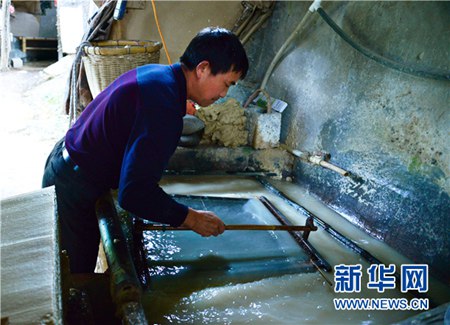
 |
|
Huang Guichun uses a screen-like tool to shake and stir until a layer of paper pulp is left. [Photo/xinhuanet.com] |
When Cai Lun figured out a new papermaking technique using bark and hemp some 1,800 years ago, during the Eastern Han Dynasty (AD 25-220), China's papermaking industry began to thrive.
Ancient papermaking has all but been replaced with modern technology, yet remarkably, the village's thousand year history of the traditional craft has stood the test of time. For its 1,600 residents, mostly of the Dong ethnic group, making paper from traditional means is as much a way of life as it is a means of making ends meet.
“Many villagers make paper or produce paper crafts as a sideline business to their general occupation during the slack season,” says Huang Zhiwen, the village's secretary.
The paper produced there is used for burning during traditional festivals. Known as Long’ao Fire Paper (or more commonly as Joss paper) it is tough, white, soft and thin. Though more environmentally-friendly methods of worshipping the ancestors have been gaining popularity, burning the paper remains a common sight in Guizhou, Hunan, Hubei and Guangdong provinces.
Long'ao Fire Paper is made from locally-grown bamboo and requires at least 55 days and 72 procedures until it is ready to be sold. Yet despite the lengthy production process, villagers are able to make a steady living from it.
“I can still make about 20 yuan ($3.04) every day, pretty enough for me to buy cigarette and alcohol,” said 82-year-old Huang Yusheng, who has made paper for most of his life. Huang still finds time and energy to help people tidy bundles of paper.
An ancient Buddhist temple atop Ao Mountain, popularized in the Tang Dynasty (AD 618-907) has provided a much-needed demand for Joss paper for centuries. The temple gained notoriety after a monk supposedly cured the then-emperor of disease. Since then, people from surrounding regions flock to the temple and stock up on Baishui-made paper before making the climb up to the temple to pray in front of the Buddha.
The allure of a modern life and the chance to make a better living is too much for some. Many villagers have left for China’s metropolitan cities, leaving the village’s age old papermaking industry short-staffed.
However, for Huang Guanchun, home is something you simply can’t put a price on. “I also tried to make a life in big cities, but after half a month I still thought hometown is the best and came back,” Huang said cheerfully. The 55-year-old has been engaging in papermaking for more than 40 years, after learning the technology from his father when he was 14. Nowadays, he makes about 500,000 pieces of paper each year, which earns him anywhere between 50,000 and 60,000 yuan ($329,270 to 395,124).
To preserve the tradition and revive its economy, the local government has been working to build Long’ao Fire Paper into a unique cultural brand in recent years. Villagers have also been encouraged to develop agricultural tourism by growing lotus plants and developing the fish farming industry.
The efforts seem to have paid off. Approximately 570,000 visitors came to the village in 2015, ensuring the traditions remain a central part of the local economy.
 |
|
The picturesque Baishui village sits among rivers and mountains in Guizhou province. [Photo/xinhuanet.com] |